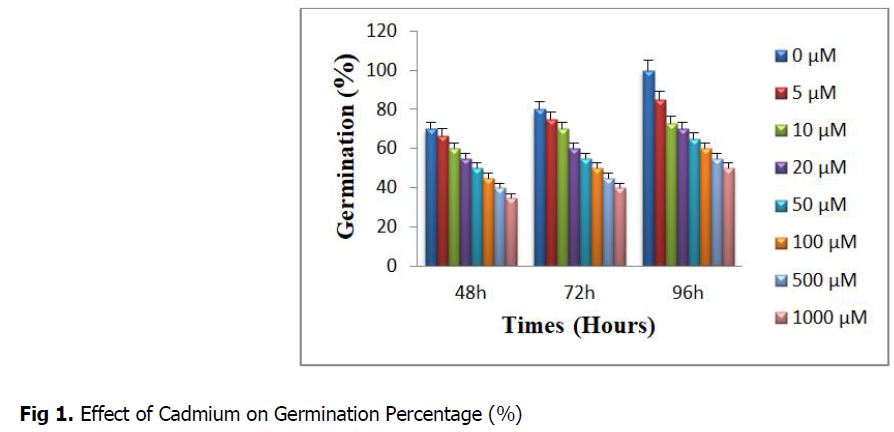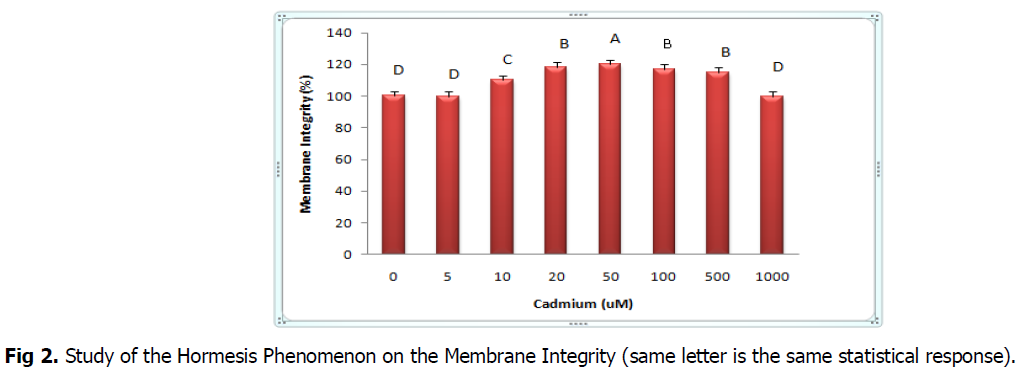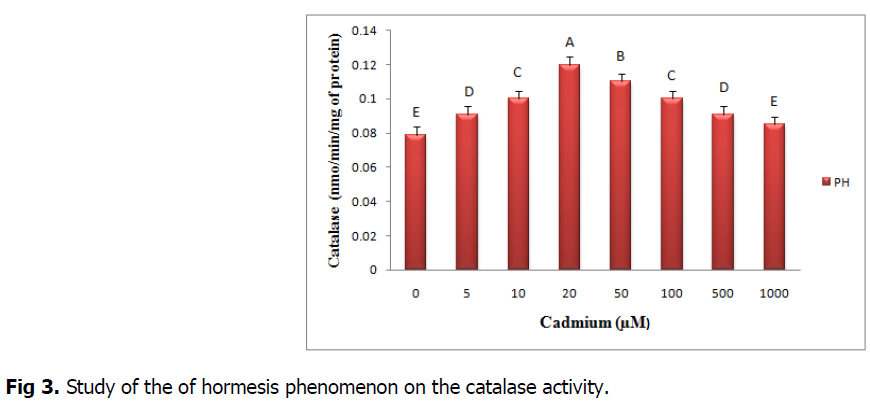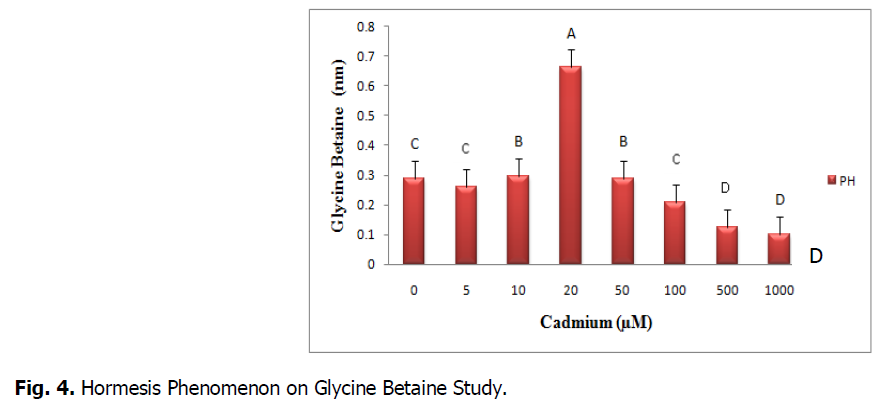Research - (2022) Volume 12, Issue 6
Hormetic responses of durum wheat (Triticum durum desf.) against cadmium stress
I. Ghozlene1, B. Houria1, D. Mohammed-Reda1 and R. Rachid2*Abstract
The Hormetic dose-response relationships resulting from environmental polluting agents are often characterized by low dose stimulation and high dose inhibition, which confirms as well the general phenomenon of hormesis with a considerable implication related to the ecological risk assessment. In the present paper, an approach based on a plant model attempts to describe an assessment of the hormoesis effect of cadmium (Cd) on the morphophysiological and biochemical results on durum wheat. The results show that a poor cadmium concentration induces a stimulation of catalase activity It also resulted in an electrolyte release from the plasma membrane as well as an induction of glycine betaine. On the other hand, the treatment with a strong concentration of cadmium resulted in an inhibition of catalase activity, as well as a downward of betaine glycine and electrolytes. The results are exposed in an inverted U-shaped curve. The phenomenon of cadmium-induced hormesis in durum wheat can be linked to the activation of adaptive pathways.
Keywords
Durum wheat, Cadmium, Hormesis, Lipid peroxidation, Integrity of the membrane and Catalase.
Introduction
Hormesis is a biphasic dose-response phenomenon characterized by a poor dose stimulation and a high dose inhibition (Calabrese, 2008). It is known that the manifestation of paradoxical effects is as the following:
The hormesis is a quantitative manifestation of a mending process of an adaptive nature, and these adaptive phenomena responses account for a specific kind of hormesis (Olivieri, 1999; Calabrese et al., 2007; Calabrese, 2008; Mattson, 2008).
At the cellular ladder, exogenous substances are often at the origin of the oxidative stress, mainly contributing to the lipid peroxidation (Guo et al., 2007, Razinger et al., 2008).
Faced with these aggressions, plants develop defense mechanisms to keep the cellular homeostasis. (Issaad et al., 2014).
A large number of studies proves that the hormesis effect is maybe related to the oxidative stress level (Yang et al., 2007). Cadmium (Cd) is extensively recognized as an environmental contaminant of soil, and it leads to hormesis responses in some organisms (Calabrese et al.,1999, Nascarella et al., 2003, Lair et al., 2008).
Heavy metal pollution has become one of the most critical environmental problems (Elkhawaga, 2011). The discovery of metals is a fundamental and basic step in the human history, which is considerably present in all compartments of the environment, particularly in water and their concentrations vary according to the element taken into the consideration (Maud, 2005).
Cadmium is toxic at small concentrations and plants are influenced by this toxicity (Habi, 2009) as it represents a non-biodegradable heavy metal and thus lasts in the environment for long periods of time.
In this present research we focused on the study of the hormesis phenomenon on hard wheat plants treated with cadmium.
Materials and Methods
Our work was performed in the Cell Toxicology Laboratory of Badji Mokhtar Annaba University.
Biological material
The biological material used in this piece of research is durum wheat of the family Poaceae specifically Triticum durum Desf. The organs chosen to carry out this study are: the leaves and roots. The samples come from the Algerian Cereals Interprofessional Office (OAIC) of El Hadjar, Annaba, Algeria. We used the Semito Ord variety.
Chemical equipment
In our work we have used cadmium chloride (CdCl2): inorganic compound consisting of cadmium and chlorine.
We used seven concentrations: (5 μM, 10 μM, 20 μM, 50 μM, 100 μM, 500 μM, and 1000 μM). The carried-out tests in our experiment were the subject of three repetitions and the obtained results are expressed by the average.
Conduct of the test
Durum wheat seeds are placed in Petri boxes with filter paper at a rate of 10 per box (Table 1).
| Compound | Concentrations (µM) | |||||||
|---|---|---|---|---|---|---|---|---|
| T | C1 | C2 | C3 | C4 | C5 | C6 | C7 | |
| Cadmium | 0 | 5 | 10 | 20 | 50 | 100 | 500 | 1000 |
Table 1. The various concentrations of cadmium.
Three repetitions are performed to each cadmium concentration. The treatment is carried out by the watering of seeds on a volume of 7.5 ml/box to each prepared solution in the course of 4 days. Distilled water is used for the control.
Studied parameters
The germination percentage
The percentage of germination is identified after 48, 72 and 96 hours of treatment. The number of seeds which have sprouted and whose length of at least one of their roots exceeds 2 mm is considered having sprouted (Ben Hamouda et al., 2001).
Membrane integrity
The percentage of cellular integrity consists of measuring the release of electrolytes generated by the partial destruction of the plasma membrane.
In this method we first took of 3 samples (stage 1 slip) from each level of stress, then rinsed them with distilled water, and then cut them into small pieces of 1cm and collected into test tubes containing 10 ml of distilled water.
The tubes are tightly closed with cotton and aluminum foil and maintained 24 hours at room temperature.
After 24 hours, the first interpretation is performed using a conductivity meter while gently placing the probe in the tube after calibration of the device.
The second reading is performed after 24 hours of the first time after tubes autoclaving at 80°C for 20 minutes.
We take 0.5 g of plant material (leaves) which are placed in 20 ml of distilled water for 48h at 25°C. They are left to cool. Then we add 0.5 ml of H2SO4 and we let them in ice for 1h. The samples reading is carried out using a spectrometer at a wavelength of 365 nm. (Grieve and Grattan, 1983).
Enzymatic determination
Preparation of the enzymatic extract
The enzymatic extract used in our work is prepared for the determination of catalase activity.
After 14 days of treatment, the fresh roots of both varieties of T. durum (1 g) are ground cold with a mortar in 5ml of phosphate buffer (50 mM phosphate, pH 7.5). The homogenate is then filtered with an adequate cloth before cold centrifugation (12000 g for 20 min). The supernatant obtained is used as an extract determine the enzymatic activity.
The method used is that of (Cakmak and Horst, 1991, Boscoloa et al., 2003). The decreasing in absorbance is recorded withing three minutes for a wavelength of 240 nm and a molar linear extinction coefficient ε=39400 M-1.cm-1.L
Reaching a final volume of 3 ml, the reaction mixture contains: 100 μl of the crude enzyme extract, 50 μl of 0.3% H2O2 hydrogen peroxide and 2850 μl of phosphate buffer (50 mM, pH7.2).
The calibration of the device is done in the absence of the enzyme extract. The reaction is triggered by the addition of hydrogen peroxide. The catalase activity is expressed in nmol/min/mg of proteins.
Statistical analyzes
All measurements were replicated three times. Mean values and standard gaps (S.D.) were calculated by Microsoft Office Excel 2007 regarding all data in this article.
Results
Percentage Of Germination (%)
Fig. 1 represents the germination percentage of durum wheat seeds of Simeto variety measured during 4 days (48h, 72h and 96h).

Fig 1: Effect of Cadmium on Germination Percentage (%)
In this bar chart we note that the percentage of germination of seeds treated with cadmium increases according to time and decreases according to the control. The statistical study reveals that cadmium-treated seeds decrease has reached 50%.
Membrane integrity
The Fig. 2 represents the membrane integrity expressed by the percentage of released electrolytes at the durum wheat root treated by low and high cadmium concentrations.

Fig 2: Study of the Hormesis Phenomenon on the Membrane Integrity (same letter is the same statistical response).
The Fig. 2 shows an upward in the release of electrolytes in roots exposed to concentrations: 10, 20, 50, 100 and 500 μm. The highest concentration (1000 μm) causes a downward in the percentage of electrolytes. This increase is 17% according to the control.
Catalase activity
Fig. 3 refers to the evolution of the catalase activity in the durum roots treated with various concentrations of cadmium.

Fig 3: Study of the of hormesis phenomenon on the catalase activity.
Effects of different Cd concentrations on the durum roots indicate a stimulation at poor concentration and inhibition at high concentration.
The Fig. 3 shows stimulation at the concentration 20 μm (A) compared to 0, 5, 10, 500 and 1000 μm.
Betaine glycine
Fig. 4 shows the average Betaine Glycine content in the durum wheat leaves treated by the different cadmium concentrations.

Fig 4: Hormesis Phenomenon on Glycine Betaine Study.
We notice that treatment by low concentrations induced a stimulation of the average grade of Glycine Betaine. The stimulation threshold is recorded at the 20 μm concentration (A) and tends to fall at the strongest concentrations. This decrease is 130% (D) according to the threshold (A).
Discussion and Conclusion
The homesis phenomenon is used in toxicology as a study model aiming to carry out chemical risk assessments. It has been established that with plants the challenge with different levels of stress is an adaptive process, reminiscent with the hormesis phenomenon this stress can be considered as "eustress" (beneficial stress) if the effect is similar to the hormetic effect at low doses of a toxin, or "distress" (harmful stress) if its level causes an irreversible or negative damage on the plant (Hideg et al., 2013)
Glycine betaine (GB) is among the numerous compounds found in plants and known for their response to abiotic stress (Venkatesan and Chellappan 1998, Mansour 2000, Mohanty et al., 2002, Yang et al., 2003). GB is mainly present in the chloroplast where it perfoms an essential role in the adjustment and protection of the thylakoid membrane and in keeping the photosynthetic efficiency (Robinson and Jones, 1986, Genard et al., 1991). Many studies show that GB accumulates as a response to stress in plants including sugar beet (Beta vulgaris), spinach (Spina-cia oleracea), barley (Hordeum vulgare) and wheat (Triticum aesivum) (Weimberg et al., 1984, Fallon and Phillips, 1989, McCue and Hanson, 1990, Rhodes and Hanson, 1993, Yang et al., 2003).
The percentage of cell integrity is a measure of electrolyte release following partial destruction of the plasma membrane. Various studies have shown that heavy metal treatment increases the level of electrolytes in the tissues of plants. However, our results show an increase in electrolytes in roots treated at low concentrations. While the roots treated with high concentrations show a decrease in membrane integrity percentage. Similar results have been reported in a study on the guava seedlings stressed by lead (Wang et al., 2010) and the work of Lian et al., 2011 on the stimulating effect induced by a low concentration of cadmium on Lonicera japonica Thunb. Our results coincided with the phenomenon of the hormesis in toxicology (Calabrese and Baldwin, 2005; Rouabhi et al., 2006; 2008), which implies an effect of stimulation through weak doses and a reduction at strong doses. Oxidative stress is responsible for membrane destruction due to a disruption in the balance between ROS production and the effectiveness of antioxidant defense (Wiegand and Pflugmacher, 2005).
As for catalase activity, our results stress the major role of the enzyme in the cadmium hormetic effect on the antioxidant system of durum wheat; they match the results of Yan et al., 2009, which highlighted the hormetic effect of cadmium on antioxidant enzymes activity in the earhworm Eisenia fertida. The analysis of the results recorded in our experimental sample show that cadmium at low concentration leads to a moderate production of ROS, that can be seen in a release of electrolytes. These ROS cause the stimulation of a cellular defense system among which glycine betaine and catalase activity. This stimulation has alowed the development of an adapting mechanism in the treated wheat, with high cadmium concentrations.
References
Ali, C., Réda, D.M., Rachid, R., Houria, B. (2009). Cadmium induced changes in metabolic function of mitochondrial isolated from potato tissue (Solanum tuberosum L.). American Journal of Biochemistry and Biotechnology, 5:35-39.
Batyan, A.N., Frumin, G.T., Bazylev, V.N. (2009). Fundamentals of General and Environmental Toxicology, SpetsLit, St. Petersburg, Russia.
Ben-Hammouda, M., Ghorbal, H., Kremer, R., Oueslati, O. (2001). Allelopathic effects of barley extracts on germination and seedlings growth of bread and durum wheats. Agronomie, 21:65-71.
Google Scholar, Crossref, Indexed at
Boscolo, P.R., Menossi, M., Jorge, R.A. (2003). Aluminum-induced oxidative stress in maize. Phytochemistry, 62:181-189.
Google Scholar, Crossref, Indexed at
Bouchama, K., Rouabhi, R., Djebar, M.R. (2016). Behavior of Phragmites australis (CAV.) Trin. Ex Steud used in phytoremediation of wastewater contaminated by cadmium. Desalination and Water Treatment, 57:5325-5330.
Cakmak, I., Horst, W.J. (1991). Effect of aluminium on lipid peroxidation, superoxide dismutase, catalase, and peroxidase activities in root tips of soybean (Glycine max). Physiologia Plantarum, 83:463-468.
Calabrese, E.J., Baldwin, L.A., Holland, C.D. (1999). Hormesis: a highly generalizable and reproducible phenomenon with important implications for risk assessment. Risk Analysis, 19:261-281.
Google Scholar, Crossref, Indexed at
Calabrese, E.J., Blain, R. (2005). The occurrence of hormetic dose responses in the toxicological literature, the hormesis database: an overview. Toxicology and Applied Pharmacology, 202:289-301.
Google Scholar, Crossref, Indexed at
Calabrese, E.J., Bachmann, K.A., Bailer, A.J., Bolger, P.M., Borak, J., Cai, L., Mattson, M.P. (2007). Biological stress response terminology: integrating the concepts of adaptive response and preconditioning stress within a hormetic dose–response framework. Toxicology and Applied Pharmacology, 222:122-128.
Google Scholar, Crossref, Indexed at
Calabrese, E.J., Stanek III, E.J., Nascarella, M.A., Hoffmann, G.R. (2008). Hormesis predicts low-dose responses better than threshold models. International Journal of Toxicology, 27:369-378.
Google Scholar, Crossref, Indexed at
El-Khawaga, A.S.A. (2011). Morphological and Metabolic Repons of Aspergillus nidulans and Fusarium oxysporum to Heavy Metal Stress. Journal of Applied Sciences Research, pp:1737-1745.
Fallon, K.M., Phillips, R. (1989). Responses to water stress in adapted and unadapted carrot cell suspension cultures. Journal of Experimental Botany, 40:681-687.
Gasmi, S., Rouabhi, R., Kebieche, M., Salmi, A., Boussekine, S., Toualbia, N., Djabri, B. (2016). Neurotoxicity of acetamiprid in male albino rats and the opposite effect of quercetin. Biotechnology: An Indian Journal, 12:113.
Genard, H., Le Saos, J., Billard, J.P., Tremolieres, A., Boucaud, J. (1991). Effect of salinity on lipid composition, glycine betaine content and photosynthetic activity in chloroplasts of Suaeda maritima. Plant Physiology and Biochemistry (Paris), 29:421-427.
Grieve, C.M., Grattan, S.R. (1983). Rapid assay for determination of water soluble quaternary ammonium compounds. Plant and Soil, 70:303-307.
Guo, B., Liang, Y.C., Zhu, Y.G., Zhao, F.J. (2007). Role of salicylic acid in alleviating oxidative damage in rice roots (Oryza sativa) subjected to cadmium stress. Environmental Pollution, 147:743-749.
Salah, H. (2018). Etude de la Métallo-résistance et de l’Halo-tolérance des Entérobactéries Isolées des Eaux de Surface de la Région de Sétif.
Hideg, É., Jansen, M.A., Strid, A. (2013). UV-B exposure, ROS, and stress: inseparable companions or loosely linked associates?. Trends in Plant Science, 18:107-115.
Google Scholar, Crossref, Indexed at
Ghozlene, I., Mohammed-Reda, D., Rachid, R., Houria, B. (2014). ROS and antioxidant system of triticum durum after water stress. Annual Research and Review in Biology, pp:1241-1249.
Lair, G.J., Graf, M., Zehetner, F., Gerzabek, M.H. (2008). Distribution of cadmium among geochemical fractions in floodplain soils of progressing development. Environmental Pollution, 156:207-214.
Google Scholar, Crossref, Indexed at
Mansour, M.M.F. (2000). Nitrogen containing compounds and adaptation of plants to salinity stress. Biologia Plantarum, 43:491-500.
Mattson, M.P. (2008). Hormesis defined. Ageing Research Reviews, 7:1-7.
Google Scholar, Crossref, Indexed at
Achard-Joris, M. (2005). Etudes biochimiques et génétiques de la réponse adaptative de mollusques face aux contaminations métalliques et au stress oxydant.
McCue, K.F., Hanson, A.D. (1990). Drought and salt tolerance: towards understanding and application. Trends in Biotechnology, 8:358-362.
Moussavou Moudouma, C.F. (2010). Etude des mécanismes d’accumulation du cadmium chez Arabidopsis thaliana (écotype Wassilewskija) et chez un mélèze hybride (Larix x eurolepis) par des approches moléculaire et développementale.
Nascarella, M.A., Stoffolano Jr, J.G., Stanek III, E.J., Kostecki, P.T., Calabrese, E.J. (2003). Hormesis and stage specific toxicity induced by cadmium in an insect model, the queen blowfly, Phormia regina Meig. Environmental Pollution, 124:257-262.
Google Scholar, Crossref, Indexed at
Olivieri, G. (1999). Adaptive response and its relationship to hormesis and low dose cancer risk estimation. Human and Experimental Toxicology, 18:440-442.
Google Scholar, Crossref, Indexed at
Razinger, J., Dermastia, M., Koce, J.D., Zrimec, A. (2008). Oxidative stress in duckweed (Lemna minor L.) caused by short-term cadmium exposure. Environmental Pollution, 153:687-694.
Google Scholar, Crossref, Indexed at
Rhodes, D., Hanson, A.D. (1993). Quaternary ammonium and tertiary sulfonium compounds in higher plants. Annual Review of Plant Physiology and Plant Molecular Biology, 44:357-384.
Google Scholar, Crossref, Indexed at
Robinson, S.P., Jones, G.P. (1986). Accumulation of glycinebetaine in chloroplasts provides osmotic adjustment during salt stress. Functional Plant Biology, 13:659-668.
Rouabhi, R., Djebar-Berrebbah, H., Djebar, M.R. (2006). on Freshwater Microinvertebrate (Tetrahymena pyriformis). Journal of Applied and Environmental Biology, 12:514-517.
Rachid, R., Djebar-Berrebbah, H., Djebar, M.R. (2008). Growth, chitin and respiratory metabolism of Tetrahymena pyriformis exposed to the insecticide Novaluron. American-Eurasian Journal of Agricultural and Environmental Science, 3:873-881.
Schatz, A., Schalscha, E.B., Schatz, V. (1964). Soil organic matter as a natural chelating material. Part 2: The occurrence and importance of paradoxical concentration effects in biological systems. Compost Science, 5:6-30.
Toualbia, N., Rouabhi, R., Salmi, A. (2017). Evaluation of cytochrome c level and mitochondrial dysfunction biomarkers of Oryctolagus cuniculus liver exposed to Chlorpyrifos. Toxicology and Environmental Health Sciences, 9:325-331.
Google Scholar, Crossref, Indexed at
Wang, C.R., Tian, Y., Wang, X.R., Yu, H.X., Lu, X.W., Wang, C., Wang, H. (2010). Hormesis effects and implicative application in assessment of lead-contaminated soils in roots of Vicia faba seedlings. Chemosphere, 80:965-971.
Google Scholar, Crossref, Indexed at
Yang, W.J., Rich, P.J., Axtell, J.D., Wood, K.V., Bonham, C.C., Ejeta, G., Rhodes, D. (2003). Genotypic variation for glycinebetaine in sorghum. Crop Science, 43:162-169.
Yang, P., He, X.Q., Peng, L., Li, A.P., Wang, X.R., Zhou, J.W., Liu, Q.Z. (2007). The role of oxidative stress in hormesis induced by sodium arsenite in human embryo lung fibroblast (HELF) cellular proliferation model. Journal of Toxicology and Environmental Health, Part A, 70:976-983.
Weimberg, R., Lerner, H.R., Poljakoff‐Mayber, A. (1984). Changes in growth and water‐soluble solute concentrations in Sorghum bicolor stressed with sodium and potassium salts. Physiologia Plantarum, 62:472-480.
Google Scholar, Crossref, Indexed at
Wiegand, C., Pflugmacher, S. (2005). Ecotoxicological effects of selected cyanobacterial secondary metabolites a short review. Toxicology and Applied Pharmacology, 203:201-218.
Google Scholar, Crossref, Indexed at
Venkatesan, A., Chellappan, K.P. (1998). Accumulation of proline and glycine betaine in Ipomoea pes-caprae induced by NaCl. Biologia Plantarum, 41:271-276.
Author Info
I. Ghozlene1, B. Houria1, D. Mohammed-Reda1 and R. Rachid2*2Toxicology and Ecosystems Pathologies Laboratory, Larbi Tebessi University, Tebessa, Algeria
Citation: Ghozlene, I., Houria, B., Mohammed-Reda, D., Rachid, R. (2022). Hormetic responses of durum wheat (Triticum durum desf.) against cadmium stress. Ukrainian Journal of Ecology. 12:26-31.
Received: 22-Jun-2022, Manuscript No. UJE-22-67376; , Pre QC No. P-67376; Editor assigned: 24-Jun-2022, Pre QC No. P-67376; Reviewed: 07-Jul-2022, QC No. Q-67376; Revised: 13-Jul-2022, Manuscript No. R-67376; Published: 19-Jul-2022, DOI: 10.15421/2022_381
Copyright: This is an open access article distributed under the terms of the Creative Commons Attribution License, which permits unrestricted use, distribution, and reproduction in any medium, provided the original work is properly cited.
